How to Create a CRUD Application with Kotlin?
In this walkthrough, you'll discover how to develop a simple CRUD (create, read, update, delete) application using Kotlin.
We will utilize Back4app as our backend service, which simplifies data management. This guide illustrates the essential components of a CRUD system, including setting up a Back4app project, designing a flexible data schema, and executing CRUD operations with a Kotlin application.
We begin by configuring a Back4app project named Basic-CRUD-App-Kotlin that offers a scalable environment. You will create data models either manually or with the assistance of Back4app's AI Agent.
Next, you will leverage the Back4app Admin interface—a user-friendly drag-and-drop tool—to manage your data effortlessly.
Finally, you'll integrate your Kotlin application with Back4app using the Parse Java SDK (or API calls when required) while ensuring secure access management.
By the conclusion of this guide, you'll have built a production-ready Kotlin application capable of performing standard CRUD operations, complete with secure user authentication and efficient data handling.
- Learn to construct a Kotlin-based CRUD application with a robust backend.
- Understand how to architect a scalable backend and connect it with a Kotlin app.
- Master using Back4app’s intuitive Admin interface for streamlined CRUD tasks.
- Get acquainted with containerizing your Kotlin app with Docker for a smooth deployment process.
Before you begin, ensure that you have:
- An active Back4app account with a new project set up. Need guidance? See Getting Started with Back4app.
- A Kotlin development environment. Utilize an IDE such as IntelliJ IDEA, and ensure you have Kotlin and JDK 11 (or later) installed.
- Basic knowledge of Kotlin, object-oriented programming, and REST APIs. Consult the Kotlin documentation if required.
- Log in to your Back4app account.
- Click on the “New App” button from your dashboard.
- Input the project name: Basic-CRUD-App-Kotlin and complete the setup steps.
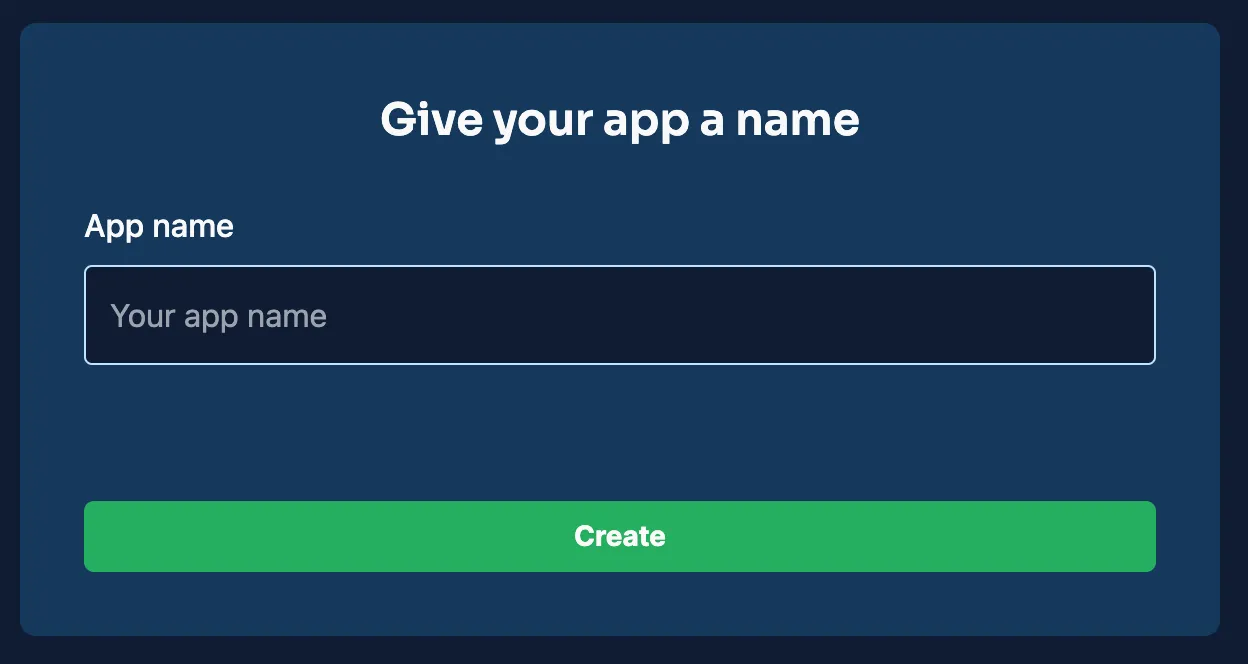
After the project is created, it will appear on your dashboard, establishing the foundation for your backend configuration.
For this CRUD application, you'll define several collections within your Back4app project. Below are sample classes and fields needed for standard CRUD operations.
Field | Data Type | Purpose |
|---|---|---|
_id | ObjectId | System-generated unique identifier. |
title | String | Name of the item. |
description | String | Brief summary describing the item. |
createdAt | Date | Record creation timestamp. |
updatedAt | Date | Timestamp for the latest modification. |
Field | Data Type | Purpose |
|---|---|---|
_id | ObjectId | Automatically generated unique identifier. |
username | String | Unique username for each user. |
String | Distinct email address. | |
passwordHash | String | Securely encrypted user password. |
createdAt | Date | Account creation timestamp. |
updatedAt | Date | Timestamp for account modifications. |
You can manually add these collections and fields directly through the Back4app dashboard.
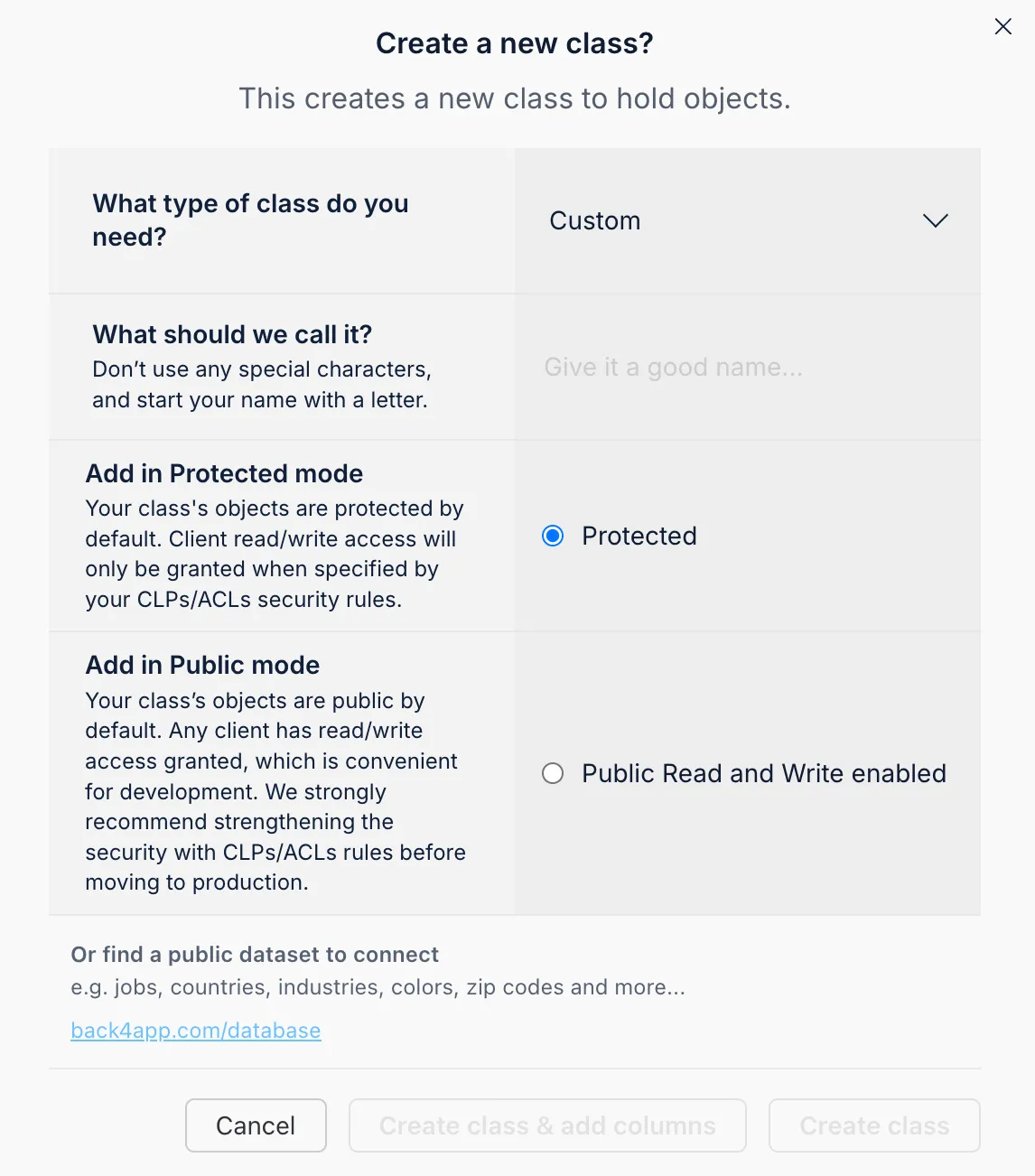
You can define fields by choosing the data type, naming the field, assigning default values, and marking required fields.
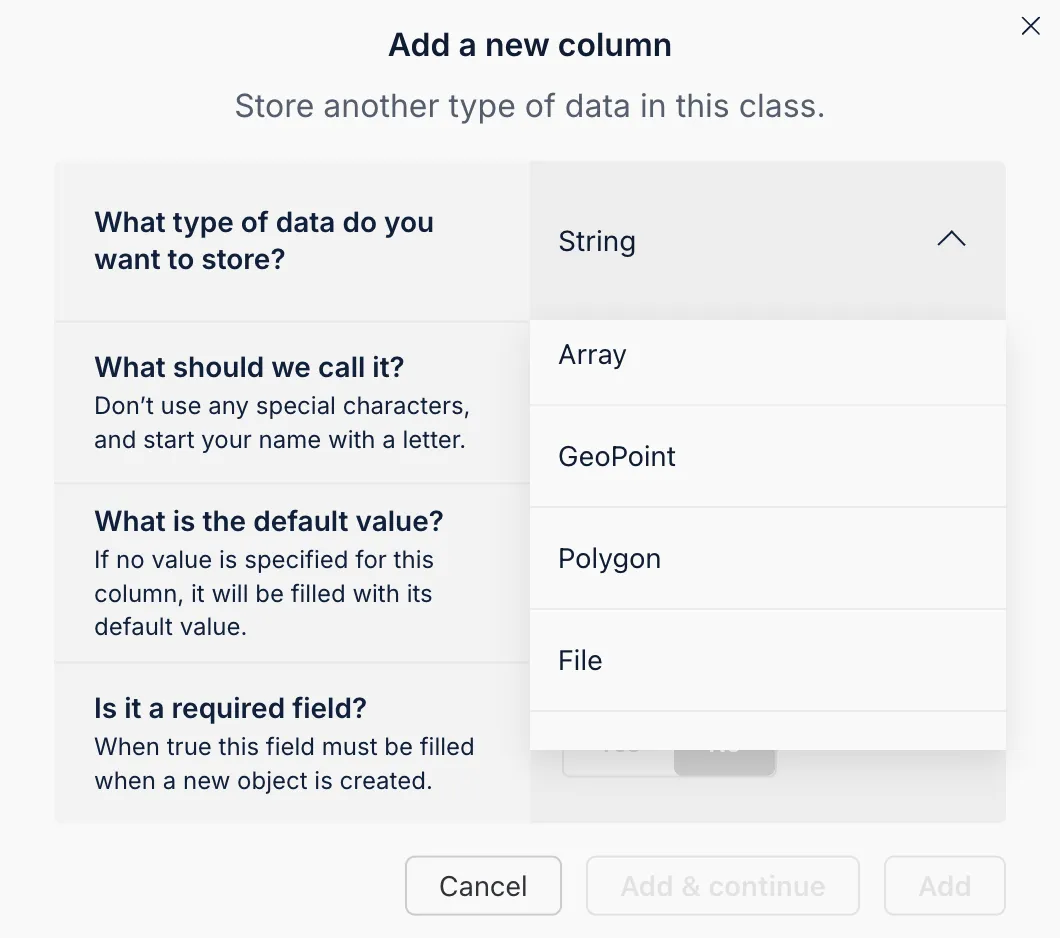
The Back4app AI Agent simplifies schema setup by automatically generating the data model based on your description. This efficient tool speeds up project initialization and ensures your schema supports all CRUD functionalities.
- Locate the AI Agent: Log into your Back4app dashboard and find the AI Agent within the project settings.
- Detail Your Data Schema: Provide a prompt outlining the required collections and their respective fields.
- Review and Confirm: Inspect the proposed schema and approve it to implement the changes.
This AI-powered feature minimizes manual configuration and optimizes your data model for CRUD operations.
The Back4app Admin interface is a no-code solution that simplifies backend data management. Its intuitive design allows you to easily create, view, modify, and delete records.
- Go to the “More” menu on your Back4app dashboard.
- Select “Admin Interface” and then click on “Enable Admin Interface.”
- Configure your admin credentials by setting up an initial administrator account. This also establishes roles (e.g., B4aAdminUser) and system collections.
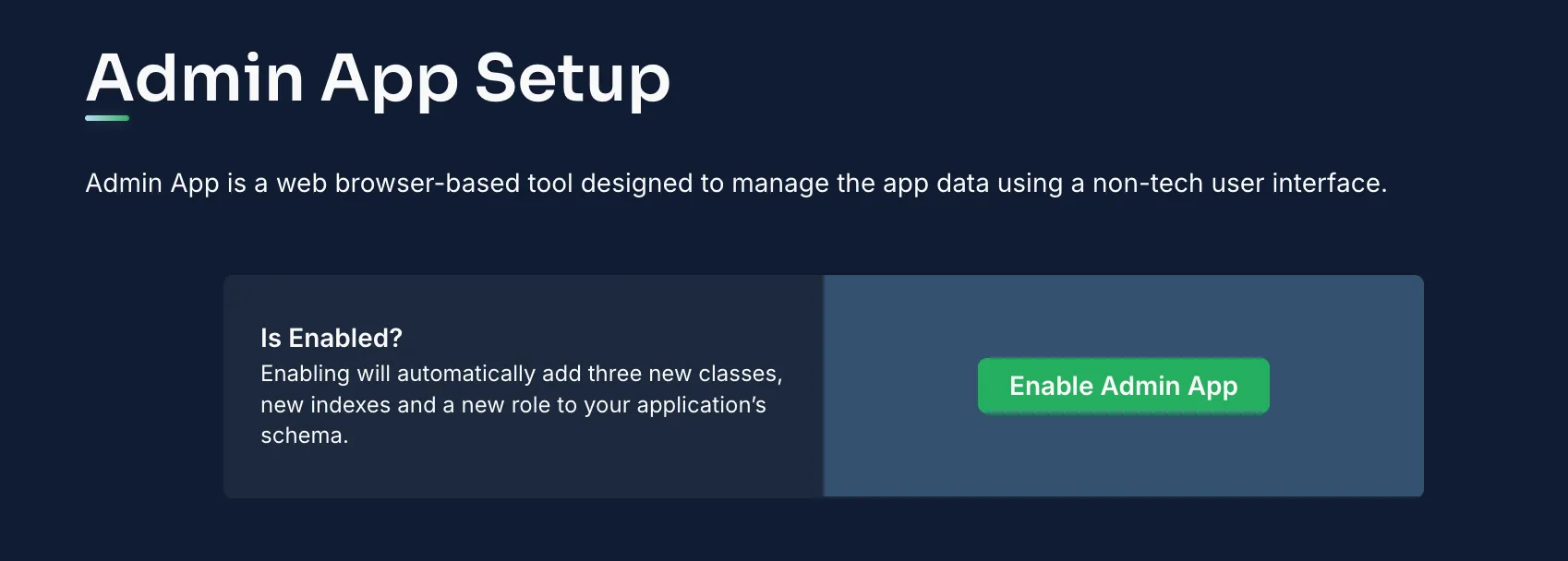
Once activated, sign in to the Admin Interface to manage your application data.
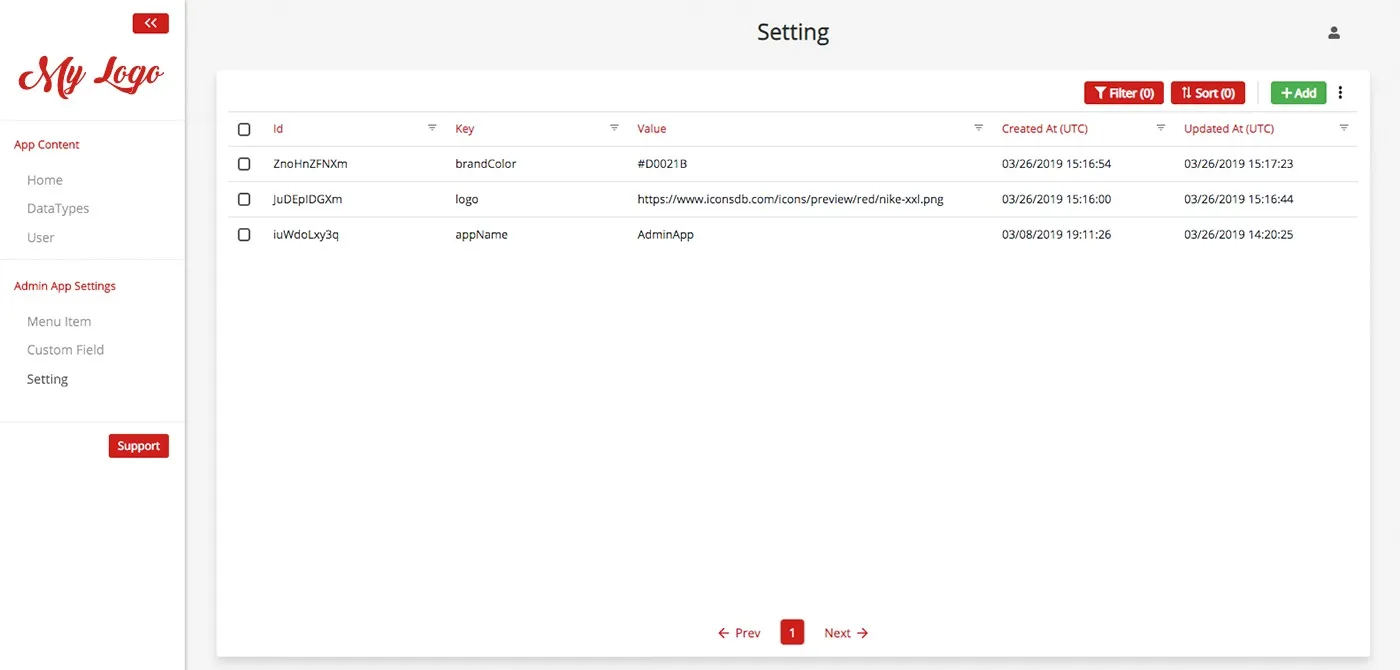
Within this interface, you can:
- Insert Records: Utilize the “Add Record” option in a collection (like Items) to input new data.
- Inspect and Modify Records: Click on a record to review or update its fields.
- Remove Records: Delete records that are no longer needed.
This user-friendly interface streamlines data management significantly.
After configuring your backend, the next phase is to link your Kotlin application with Back4app. It’s important to note that although we are using the Parse Java SDK, Kotlin’s seamless interoperability with Java allows you to integrate it without any issues.
Include the Parse SDK Dependency: If you are using Gradle, add the following to your build.gradle.kts:
Kotlin1dependencies { 2 implementation("com.parse:parse-sdk:1.18.0") 3}Initialize Parse in Your Kotlin Application: Create a configuration file (e.g., ParseConfig.kt):
Kotlin1// ParseConfig.kt 2import com.parse.Parse 3 4object ParseConfig { 5 fun initialize() { 6 Parse.initialize( 7 Parse.Configuration.Builder("YOUR_APPLICATION_ID") 8 .clientKey("YOUR_KOTLIN_KEY") 9 .server("https://parseapi.back4app.com") 10 .build() 11 ) 12 } 13}Implement CRUD Methods in Kotlin: For example, create a service to manage items:
Kotlin1// ItemsService.kt 2import com.parse.ParseException 3import com.parse.ParseObject 4import com.parse.ParseQuery 5 6object ItemsService { 7 fun getItems(): List<ParseObject>? { 8 return try { 9 ParseQuery.getQuery<ParseObject>("Items").find() 10 } catch (e: ParseException) { 11 println("Error retrieving items: ${'$'}{e.message}") 12 null 13 } 14 } 15 16 fun createItem(title: String, description: String) { 17 val item = ParseObject("Items") 18 item.put("title", title) 19 item.put("description", description) 20 try { 21 item.save() 22 println("Item successfully created.") 23 } catch (e: ParseException) { 24 println("Failed to create item: ${'$'}{e.message}") 25 } 26 } 27 28 fun updateItem(objectId: String, newTitle: String, newDescription: String) { 29 val query = ParseQuery.getQuery<ParseObject>("Items") 30 try { 31 val item = query.get(objectId) 32 item.put("title", newTitle) 33 item.put("description", newDescription) 34 item.save() 35 println("Item updated successfully.") 36 } catch (e: ParseException) { 37 println("Update failed: ${'$'}{e.message}") 38 } 39 } 40 41 fun deleteItem(objectId: String) { 42 val query = ParseQuery.getQuery<ParseObject>("Items") 43 try { 44 val item = query.get(objectId) 45 item.delete() 46 println("Item deleted successfully.") 47 } catch (e: ParseException) { 48 println("Deletion error: ${'$'}{e.message}") 49 } 50 } 51}
If you prefer not to use the Parse SDK, you can execute CRUD operations via REST calls. For example, to retrieve items using REST:
Integrate these API calls within your Kotlin classes as needed.
Ensure your data remains secure by setting up ACLs on your objects. For instance, to create an item that is accessible only by its owner:
Set up CLPs via the Back4app dashboard to enforce default access policies, ensuring only authenticated users interact with sensitive collections.
Back4app leverages Parse’s built-in User collection for authentication. In your Kotlin app, you can handle user registration and login as follows:
This structure can be extended for session management, password resets, and additional authentication mechanisms.
Congratulations! You have successfully built a Kotlin-based CRUD application integrated with Back4app.
In this guide, you set up a project named Basic-CRUD-App-Kotlin, defined data collections for Items and Users, and managed your data through the Back4app Admin interface.
Furthermore, you connected your Kotlin app via the Parse SDK (or API calls) and implemented robust security practices.
Next Steps:
- Expand the Application: Integrate additional features such as advanced search capabilities, detailed item views, or real-time updates.
- Enhance Backend Functionality: Consider exploring cloud functions, third-party API integrations, or advanced role-based access controls.
- Deepen Your Expertise: Visit the Back4app documentation for further guidance and advanced tutorials.
Happy coding and best of luck with your Kotlin CRUD application!
